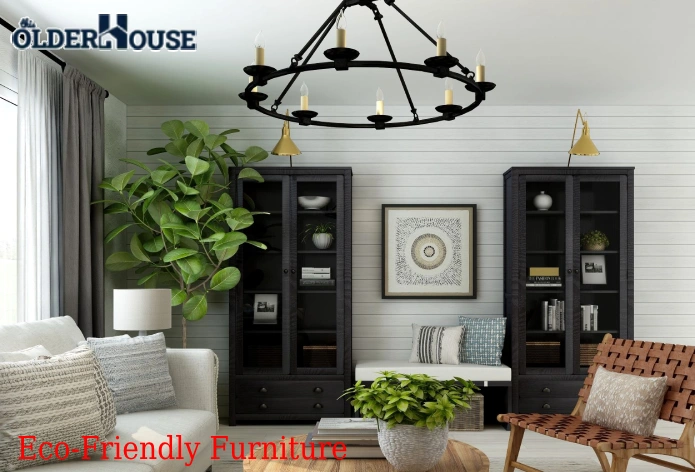An Engaging Hook
Picture this: a cozy living room adorned with furniture that not only looks beautiful but also tells a story of environmental consciousness. Imagine snuggling up on a plush sofa crafted from organic materials, surrounded by sleek coffee tables made from reclaimed wood. This is the world of eco-friendly furniture, a realm where style meets sustainability, and every piece in your home becomes a testament to your commitment to a greener future.
Thesis
In today’s increasingly environmentally conscious world, the demand for sustainable and eco-friendly furniture is on the rise. This article will explore the benefits of eco-friendly furniture, the materials used, and the principles of sustainable design that contribute to a more sustainable future.
Introduction
Eco-Friendly Furniture Defined
Eco-friendly furniture is made from renewable resources, recycled materials, or methods that minimize environmental impact. It includes pieces made from reclaimed wood, bamboo, cork, organic cotton fabrics, and other certified sustainable materials.
Benefits of Eco-Friendly Furniture
- Reduces waste in landfills
- Conserves natural resources
- Supports healthier indoor air quality through low VOC emissions
- Promotes sustainability in the home goods sector
Materials and Designs
Reclaimed Wood
Wood salvaged from old buildings, pallets, or other sources, reducing the need for new timber. These pieces often carry a unique patina and character that cannot be replicated, making each item a one-of-a-kind treasure.
Advantages of Reclaimed Wood
- Gives new life to discarded materials
- Reduces the demand for freshly harvested timber
- Adds character and a sense of history to your home
Bamboo
A fast-growing, renewable resource that matures quickly and does not require pesticides. Bamboo is incredibly versatile and can be used to create a range of furniture pieces, from beds and chairs to shelving and tables.
The Bamboo Advantage
- Rapidly renewable, growing to full maturity in 3-5 years
- Requires minimal water and no pesticides during cultivation
- Lightweight yet sturdy, making it an excellent choice for furniture
Cork
A renewable material that is biodegradable and recyclable, and the tree remains intact during harvesting. Cork has a warm, natural feel and is an excellent insulator, making it a popular choice for flooring, wall coverings, and even furniture.
Cork: A Sustainable Wonder
- Harvested without harming the tree, making it truly renewable
- Lightweight, durable, and resistant to moisture and mold
- Offers natural insulation and sound absorption properties
Recycled Materials
Including metal, plastic, and textiles, which are diverted from landfills and given new life. These materials can be repurposed and transformed into stunning pieces of furniture, reducing the need for new resource extraction.
Giving New Life to Old Materials
- Reduces the demand for new raw materials
- Diverts waste from landfills, supporting a circular economy
- Offers a unique aesthetic with a touch of industrial charm
Innovative Designs
Utilizing modular design, which allows for disassembly and reconfiguration, facilitating repair and reuse. This approach extends the lifespan of furniture and encourages a more sustainable cycle of use.
The Power of Modular Design
- Allows for easy disassembly and reconfiguration
- Facilitates repair and replacement of individual components
- Promotes a culture of reuse and adaptation
Durability and Longevity
Sustainable furniture prioritizes the creation of products that are built to last, using high-quality materials and non-toxic finishes and adhesives to ensure healthier indoor air quality. By investing in durable pieces, you not only reduce waste but also create heirlooms that can be passed down through generations.
Energy Efficiency
Designers focus on minimizing energy consumption during the manufacturing and usage phases through various strategies, such as incorporating energy-efficient lighting solutions, utilizing natural lighting and ventilation, and integrating smart technologies that optimize energy use based on user needs.
Waste Reduction
The third principle of sustainable furniture and interior design is waste reduction, which embraces the circular economy by diverting waste from landfills and reducing the need for new resource extraction. Manufacturers are exploring innovative ways to repurpose and recycle materials, ensuring that every component of a furniture piece has a second life.
Consumer Choices and Greenwashing
As consumers, we hold the power to drive change through our purchasing decisions. By choosing eco-friendly furniture, we can reduce our carbon footprint and promote sustainability. However, it’s crucial to be aware of greenwashing, where companies make false or misleading claims about their environmental practices. Always research and verify the certifications and standards of the furniture you purchase to ensure you’re making an informed choice.
Certifications and Standards
When shopping for eco-friendly furniture, it’s important to look for certifications and standards that verify the sustainability claims made by manufacturers. Here are some of the most reputable certifications to look out for:
Forest Stewardship Council (FSC)
The Forest Stewardship Council is an international non-profit organization that promotes responsible management of the world’s forests. The FSC certification ensures that wood used in furniture production comes from responsibly managed forests, plantations, and recycled sources.
GREENGUARD
GREENGUARD is a certification program that tests for low chemical emissions from products, ensuring they meet strict standards for indoor air quality. Furniture that bears the GREENGUARD certification is designed to minimize the release of volatile organic compounds (VOCs), formaldehyde, and other harmful chemicals.
Cradle to Cradle
The Cradle to Cradle certification is a globally recognized measure of safer, more sustainable products made for the circular economy. It evaluates a product’s material health, material reuse, renewable energy and carbon management, water stewardship, and social fairness.
Sustainable Lifestyle Choices
Embracing eco-friendly furniture is just one aspect of living a more sustainable lifestyle. Here are some additional tips to help you reduce your environmental impact:
- Reduce, Reuse, Recycle: Adopt a mindset of minimalism and avoid unnecessary consumption. When possible, choose secondhand or upcycled items, and properly recycle materials that have reached the end of their useful life.
- Conserve Energy: Implement energy-saving practices in your home, such as using energy-efficient appliances, turning off lights when not in use, and adjusting your thermostat to reduce heating and cooling demands.
- Eat Sustainably: Support local and organic agriculture by purchasing seasonal produce from farmers’ markets or joining a community-supported agriculture (CSA) program. Consider reducing your meat consumption and embracing plant-based alternatives.
- Minimize Waste: Reduce your use of single-use plastics and disposable items. Opt for reusable containers, water bottles, and shopping bags. Compost food waste and consider a zero-waste lifestyle.
- Support Sustainable Businesses: Choose to support companies that prioritize environmental responsibility and ethical practices. Look for B Corp certifications, which assess a company’s impact on workers, customers, communities, and the environment.
Remember, every small step you take towards sustainable living can make a significant difference. By incorporating eco-friendly furniture into your home and adopting a more conscious lifestyle, you can contribute to a healthier planet for generations to come.
Sustainable Interior Design Inspiration
Incorporating eco-friendly furniture into your home is just the beginning. For a truly sustainable living space, consider embracing sustainable interior design principles. Here are some inspiring ideas to get you started:
Biophilic Design
Biophilic design focuses on creating a harmonious connection between the built environment and nature. This approach involves incorporating elements such as natural light, plants, and organic materials to create a sense of calm and well-being. Consider adding indoor plants, using earthy color palettes, and embracing natural textures like wood and stone.
Minimalism
A minimalist design philosophy can help reduce clutter and encourage a more conscious approach to consumption. Embrace a less-is-more mentality, and choose furniture pieces that serve multiple purposes. Opt for clean lines, neutral colors, and a focus on functional design.
Vintage and Antique Pieces
Incorporating vintage and antique furniture into your home is an excellent way to embrace sustainability. These pieces often have unique character and charm, and by giving them a new life, you’re reducing the demand for newly manufactured items. Scour antique shops, online marketplaces, or local estate sales to find one-of-a-kind treasures.
Upcycled and Repurposed Decor
Upcycling and repurposing materials is a creative way to inject sustainability into your interior design. Consider transforming old furniture into new pieces, using reclaimed wood for shelving or wall paneling, or turning vintage textiles into throw pillows or curtains.
Natural Lighting and Ventilation
Maximize the use of natural light and ventilation in your home to reduce energy consumption. Install skylights, use sheer curtains or blinds to filter sunlight, and consider strategic window placement to encourage cross-ventilation. This approach not only saves energy but also creates a more inviting and healthier living environment.
By embracing these sustainable interior design principles, you can create a home that not only reflects your personal style but also demonstrates your commitment to environmental responsibility.
Eco-Friendly Furniture Maintenance and Care
To ensure the longevity of your eco-friendly furniture, proper maintenance and care are essential. Here are some tips to help you keep your sustainable pieces looking their best:
- Follow Manufacturer Instructions: Carefully read and follow the care instructions provided by the manufacturer. Different materials may require specific cleaning methods or products.
- Use Natural Cleaners: Opt for natural, non-toxic cleaners made from ingredients like vinegar, baking soda, and plant-based surfactants. Avoid harsh chemicals that can damage the materials or release harmful fumes into your indoor environment.
- Protect from Direct Sunlight: Prolonged exposure to direct sunlight can cause fading and damage to certain materials. Use curtains, blinds, or strategically place furniture to minimize direct sunlight exposure.
- Rotate Cushions and Flip Mattresses: To ensure even wear and tear, regularly rotate cushions on sofas and chairs, and flip mattresses to prevent sagging and indentations.
- Dust and Clean Regularly: Regular dusting and cleaning can help maintain the appearance and condition of your eco-friendly furniture. Use soft cloths or microfiber dusters to remove dust and debris.
- Avoid Excessive Moisture: Excessive moisture can lead to warping, swelling, or mold growth in certain materials. Maintain proper humidity levels in your home and address any water damage promptly.
Conclusion
Eco-friendly furniture is not just a trend but an integral part of our effort to create healthier indoor spaces and minimize environmental impact. By choosing durable and eco-friendly furniture, consumers can make a positive impact on the environment and promote sustainability in their homes. So, why not start your journey towards a greener living space today? Embrace the beauty of sustainable furniture and let your home be a reflection of your commitment to a better tomorrow.
FAQs
- What is eco-friendly and sustainable furniture?
Eco-friendly and sustainable furniture is made from renewable resources, recycled materials, or through production methods that minimize environmental impact. It prioritizes durability, energy efficiency, and waste reduction. - How can furniture be environmentally friendly?
Furniture can be environmentally friendly by utilizing sustainable materials such as reclaimed wood, bamboo, cork, and recycled materials. Additionally, it can incorporate energy-efficient designs, non-toxic finishes, and modular components that facilitate repair and reuse. - What materials are worth considering for eco-friendly furniture?
Some of the most popular and sustainable materials for eco-friendly furniture include reclaimed wood, bamboo, cork, organic cotton fabrics, and recycled metals and plastics. - How does technology play a role in eco-friendly furniture production?
Technology plays a crucial role in eco-friendly furniture production through the incorporation of energy-efficient lighting solutions, smart technologies that optimize energy use, and modular designs that allow for easy disassembly and reconfiguration. - What is the secret sauce of eco-furniture?
The secret sauce of eco-friendly furniture lies in its commitment to sustainability, durability, energy efficiency, and waste reduction. By prioritizing these principles, manufacturers create furniture that not only looks great but also has a minimal environmental impact.





